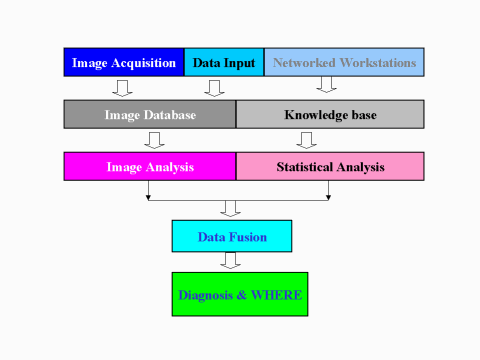Lifelinger
A new ICT-based diagnosis procedure and tool set for
early detection of cervix cancer
K. Miller1, V. Marques2, Lifelinger Consortium3
1Director, Aray UK arayltd@btinternet.com;
2Duvideo Cooperativa – Profissionais Imagem Crl , Lisbon, Portugal lifelingeradmin@duvideo.pt;
3 European Project Number.: IST-2001- Craft- 72031 http://www.lifelinger.net/menu/home.htm
Abstract – Cervical cancer is the third most common type of cancer in women. The LIFELINGER project objectives are the development, testing, validation and exploitation and early-commercialisation of a new cervix cancer early diagnosis system based on the integration of optical imaging, image analysis and statistical analysis. This paper introduces the LIFELINGER project.
I. INTRODUCTION
Cervical cancer is the third most common type of cancer in women. Cervical cancer is still a major global health problem with striking geographical variation. In the underdeveloped world, established and advanced stage disease constitutes the bulk of the problem whereas in those more developed countries, particularly those with screening programs, there has been a decline in mortality from invasive disease.
Effective screening for cervical cancer and pre-malignant lesions does requires a test which is easy to apply, inexpensive, with a good cost/benefit ratio, providing little or no discomfort to the women and with a good acceptance; and a high sensitivity and specificity to identify individuals with pre-clinical disease.
II. CERVICAL CANCER SCREENING
The cause of cervical cancer is unknown; however, virtually all cancers of the cervical epithelium arise as a consequence of human papilloma virus (HPV). A number of co-factors have been identified. These include: smokers, multiple sexual partners, early onset of sexual activity (less than 18 years) or early childbearing (less than 16 years), and others sexually transmitted diseases, specifically genital herpes and trachomatis clamydia. Approximately 4-5% of all women age 20 – 65 years will have some form of pre-cancer lesion of the cervix.
The Pap smear has been the main test for a number of years now. However, recently, its sensitivity and specificity have been questioned, with false negative rates of cytology in the 10-30% domain, which is considerably high.
Additionally there are problems related to the lack of training of medical staff reporting cervical smears. At a conference on quality standards in cervical cancer screening in the European Union some serious weaknesses in the standards of training of medical and paramedical personnel was presented [1]. Few countries have nationally organised training programmes or proficiency testing schemes for personnel who undertake the reporting of cervical smears.
In order to optimise screening and prevention and improve efficacy, the Pap test has been combined with other techniques such as cervicography, speculoscopy and colposcopy. Colposcopy is a microscopic observation of the cervix. The cervix epithelium is examined with low and high magnification, first without preparation, and afterwards after acetic acid and Lugol solution application. The visual analysis of colposcopic images is based on recognising variations in colour; mainly to assess the size, location and distribution of the lesion. Biopsies are taken from the worst areasand sent to the Histology laboratory to confirm diagnosis. Colposcopy not only determines if there is cancer, but also where.
But traditional colposcopy still requires experience for a correct interpretation of the atypical cervix patterns and recognition of the areas to biopsy. The colposcopic examination presents two major problems. It requires long-term experience and training to acquire expertise in pattern recognition; and remains extremely subjective (several studies where inter and intra-observer variations have been noted, pointed to less that 50% of lesions are agreed by all observers). The complexity of the disease is paired with the extreme subtleties of the distinctions between pathologic and non-pathologic lesion patterns leading to variations in the diagnosis between physicians and even for the same physician during his/hers examinations. The interpretation of the results of direct observation is dependent on very small, subtle and subjective differences in coloration, brightness, tissue pattern etc. that depend on the physician’s perception, background, experience and so on. The colposcopic diagnosis has a higher sensitivity (95%), but has lower specificity (45%), with positive predictive value about 82% and negative predictive value of 79%.
As such, the screening and early diagnosis of pre-malignant lesions of the cervix is a major problem of the primary health care. Improvement on the examination itself has been achieved by providing doctors with additional test, such as illuminating the cervix using filtered light and by colouring it with chemical solutions that improve colour and brightness reflection differentiation on the tissues but further scientific and technical developments are urgently needed.
III. PROJECT LIFELINGER
The LIFELINGER project is an EU project being undertaken by a consortium of companies from several EU Countries. Its objectives include the development, testing, validation and exploitation and early-commercialisation of a new cervix cancer early diagnosis system; based on the integration of optical imaging, image analysis and statistical analysis.
Some of the project’s results will include:
- An interrelated set of software tools, to be installed on a PC-Based workstation or powerful laptop computer. Additional hardware includes a CCD based camera, a light emitting device covering a wide and non-biased frequency spectrum, a fixing arm for the camera/light;
- The workstations will be networked through the Internet; thus creating a global environment that will process an increasing number of cases.
- A centrally managed database system to collect data from the networked workstations and distribute the updated database to the users of the product;
- An extendible software system that will provide users with the ability to add functionality over the time.
The PC based workstation will act as an add-on to the standard doctors equipment (colposcope) and will support the physician during the examination, identifying potential disease by ranking its likeliness against a set of predetermined parameters.

FIGURE I: LIFELINGER PROCESSING
The LIFELINGER project aims at improving the diagnosis by:
- The use of advances in state of the art IT technology.
- Implementing data fusion concepts, integrating a set of complementary image and data processing mechanisms.
- Deploying IT based image enhancing processes; reducing the needs of chemical based human tissue contrasting substances.
- Creating and maintaining a large database of cases that enables trend identification by using data mining processes.
- Deploying the expertise and specific clinical know-how of the medical specialists to the general practitioner. Consequently a much larger population will benefit, namely in areas where expert know-how is scarce.
The LIFELINGER results are expected to provide the practitioner that is performing the examination, with a tool that not only helps to better distinguish the lesion patterns and their image properties such as shapes, contrast, tone, brilliance; but also makes available, during the examination, the best available specialist know-how. Thereby improving the quality of the examination and lowering the number of incorrect pathology diagnoses.
The main Lifelinger outputs will be:
- The doctors workstation;
- The database of cases;
- The Knowledge Base subsystem;
- The image analysis subsystem;
- The data fusion subsystem;
- Overall methodology for the introduction of the ICT supported examination; and;
- Guidelines and support materials for training on the new systems.
IV. CONCLUSION
LIFELINGER is a computerised imaging aid for clinical diagnosis of cervical cancer. It is used as an aid to colposcopic examination; whose primary goal is to ensure that invasive disease is not missed. The purpose of a thorough and systematic colposcopic assessment is to assist the colposcopist in selecting the most abnormal lesions to biopsy and to rule out the presence of invasive cancer.
LIFELINGER’s benefits include:
- An innovative system that improves diagnostic accuracy and reliability.
- A record of personal details, diagnosis and treatment that correlates a wide variety of elements.
- Low production costs, since the LIFELINGER System exploits and adopts commercially available technologies.
The ideal LIFELINGER system will take one (or more) picture of the cervix, locate, characterise, grade and highlight on the display lesions and abnormal tissue, and indicate where to biopsy; within one minute; with sensitivity and specificity greater than 90% when compared to histology. This may be possible given powerful enough computers, and clever image processing algorithms. We are not there yet; but with its user extensibility feature perhaps you; networking with others; will be able to improve its performance.
References
[1] ECTPCCS Conference on Quality Assurance in Cervical Cancer Screening, 1993.
[3] C.J. James and D. Lowe, “Using dynamical embedding to isolate seizure components in the ICTAL EEG”, IEE Proceedings: Science, Measurement and Technology, vol.147(6), 2000, pp. 315-320.
For more information see: http://www.lifelinger.net/menu/home.htm
Lifelinger Related presentations
1 Lifelinger Introduction
2 European Federation for Colposcopy French Society for Colposcopy and Cervical Pathology 3rd European Congress for Colposcopy and Cervical Pathology Paris, January 23-24, 2004
2 European Union Cancer Prevalence
4 Introduction to Lifelinger (Cervical Cancer Imaging) Project – London Meeting 2004
5 5 Some Colposcopy Links
